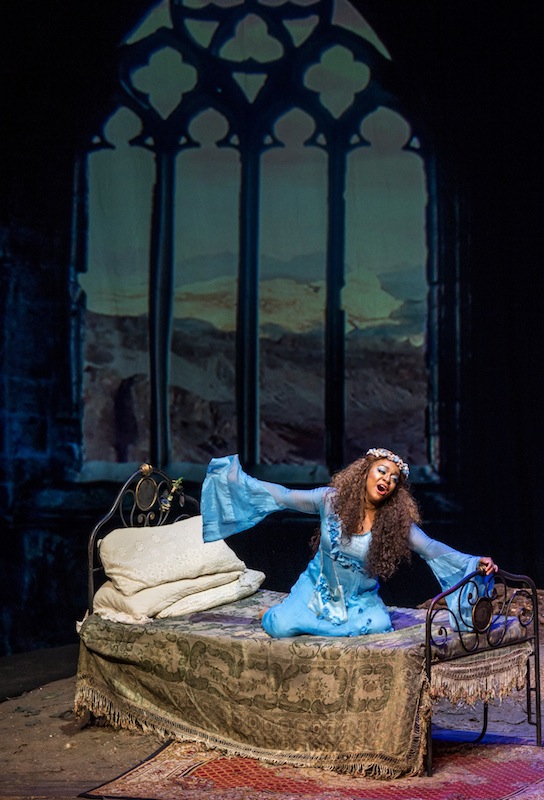New York City Opera restores Respighi rarity to sumptuous life

Brandie Sutton as the fairy Rautendelein in Respighi’s “La Campana Sommersa” at New York City Opera. Photo: Sarah Shatz
Fairy-tale characters appear in dozens of operas, from Carl Maria von Weber’s Oberon, to Richard Strauss’ Die Frau ohne Schatten, to Benjamin Britten’s A Midsummer Night’s Dream.
But few opera lovers are likely to have heard Ottorino Respighi’s La Campana Sommersa (“The Sunken Bell”), presented Friday night by New York City Opera at Jazz at Lincoln Center.
Based on Gerhart Hauptmann’s play, Die versunkene Glocke, Respighi’s 1927 opera is a decidedly strange story, even by opera standards. A bell-maker, Enrico, is at the story’s axis. Mischievous fauns have sent one of his massive church bells to the bottom of a lake, almost crushing him in the process. Enrico crosses paths with a compassionate fairy, Rautendelein, who wants to restore him and be with him in the human world. But despite Enrico’s return overtures—and by the way, he’s married—the two worlds have complications converging, and eventually the fairy hooks up with someone else, leaving Enrico to die in unrequited mortal/spirit-world amour.
Though not performed in New York since 1929 (at the Metropolitan Opera), La Campana Sommersa is richly lyrical and a score well worth championing. As one might expect from Respighi, the opera is lavishly orchestrated, with a large string contingent, in addition to extra winds and brass. The huge percussion section includes Basque drum and anvils, and the celesta adds a feeling of extravagance and opulence. Bell-like timbres are everywhere, along with echoes of the composer’s popular tone poems—the double-bass tread of Pini di Roma, the effervescent winds of Fontana di Roma.
Marc Heller was Enrico Friday night, replacing Fabio Armiliato, who was suffering from a sinus infection. Heller sang with warm, arresting resonance; in the final act–when Rautendelein revisits him as he is dying–Heller revealed a softer voice and touching characterization. As his anguished wife, Kristin Sampson showed a luscious tone, combined with appropriate sorrow, and Renata Lamanda lent her warm mezzo to make an invitingly mysterious witch.
One of the opera’s most amusing characters is L’Ondino, winningly played by Michael Chioldi, whose bold voice often announced his presence uttering “brekekekex,” an onomatopoetic word that librettist Claudio Guastalla borrowed from Aristophanes’ play, The Frogs. Chioldi also sports one of the most elaborate costumes—one of a handsome array designed by Marco Nateri—that seemed to merge The Creature from the Black Lagoon with the Cowardly Lion from The Wizard of Oz.
As the faun who taunts Enrico, Glenn Seven Allen snarled his way through the opening act in finely calibrated voice, and reappeared later, all the while sporting goat horns and a metallic green torso. Philip Cokorinos sang the Priest with stentorian force, and even more charm came from three elves: Joanna Mongiardo, Sharin Apostolou, and Magda Gartner. Female members of the NYCO Chorus and Children’s Chorus added additional sparkle, along with a corps of five dancers.
But the star of the night was soprano Brandie Sutton as the fairy Rautendelein, scampering about, mixing potions, and gazing with curiosity at the human world, all while hitting some of Respighi’s stratospheric notes with playful ease. The score may not offer immediately memorable arias, but it hardly mattered when her scenes were so sweetly charming, and sung so confidently, with riveting quiet moments.
Stage director Pier Francesco Maestrini made economical use of motion in the Rose Theater. (Though the steep rake of the set might have made some nervous about plunging into the orchestra pit, as the cast almost discovered during the curtain call.) Relying mostly on shrewd video projections, Juan Guillermo Nova conjured up a mist-laden forest, a slowly revolving moon, and the interior of Enrico’s house. Along with designer Susan Roth, their most striking contribution comes at the end of the first act, an underwater scene with bubbles, coral, and ferns.
Much of the credit for the powerful impact of Friday night’s performance was due to Ira Levin, who conducted the combined NYCO Orchestra and Italy’s L’Orchestra del Teatro Lirico di Cagliari with lushness and maximum impact. Levin led the 70-player ensemble with technical assurance and astute attention to the composer’s contrasts. Though not always technically pristine, the playing was still assured and effective, with substantial solo flute and oboe contributions, and a magical sequence for solo harp.The musicians brought red-blooded sonority to the fore in the ecstatic Technicolor climaxes.
La Campana Sommersa will be repeated 8 p.m. Saturday and 7:30 p.m. April 4 and 5, with Fabio Armiliato and Marc Heller alternating in the role of Enrico. nycopera.com; 212-721-6500.
Posted Apr 02, 2017 at 11:17 am by kirk macdonald
Totally transfixing performance, particularly the lighting and sets. Every bit as professional and captivating as any of the Met’s events to which I regularly subscribe. Wonderful orchestral contributions. Worth either of last two days for opera lovers willing to explore the Pines composer…
Posted Apr 04, 2017 at 9:32 pm by Anthony Jahn
A remarkable and ambitious work, musically complex and lush, reminiscent of Strauss and Wagner, evoking a fevered fairy world with Jungian overtones. It fills in an important area in the development of opera between the Spät Romantik and modern eras. Well sung and captivating my staged. This is what NYCO should be doing more of!